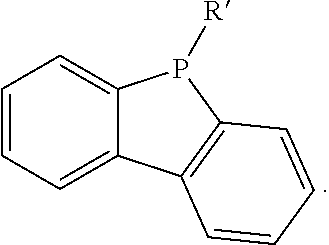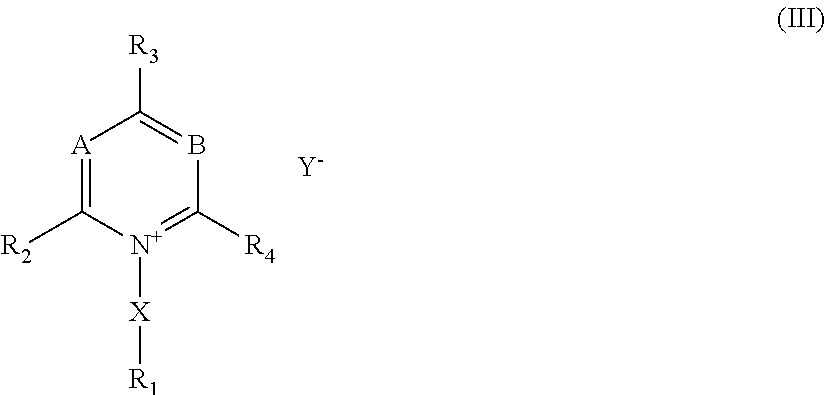Photocuring methods and articles prepared therefrom
a technology of photocuring and photoinitiator, which is applied in the field of photocuring methods, can solve the problems of not meeting the requirements of photoinitiator efficiency, or at least not to an optimal degree, and the quality of the cured final product is deteriorated, so as to achieve the effect of rapid curing and better photocuring performan
- Summary
- Abstract
- Description
- Claims
- Application Information
AI Technical Summary
Benefits of technology
Problems solved by technology
Method used
Image
Examples
invention example 1
[0202]Amplified quantum yield of 2-chlorothioxanthone (S-2) photosensitized reaction of N-methoxy-4-phenylpridinium hexafluorophosphate (OZ-1) and triphenylphosphine in acetonitrile-d3:
[0203]
[0204]The 2-chlorothioxanthone (S-2) (0.002 mol) sensitizer was added to a 3 ml solution of 0.02 molar N-methoxy-4-phenylpyridinium hexafluoro-phosphate (OZ-1) and 0.001 molar triphenylphosphine in acetonitrile-d3. In a 1×1 cm quartz cell, this solution was purged with a thin stream of argon for 2-3 minutes and then irradiated at 405 nm for 30 seconds. Argon or nitrogen was continuously passed through the reaction mixture during photolysis to purge as well as stir the solution. After photolysis, 1H NMR spectrum of the photolysate was recorded and the percent conversion of the starting materials was determined by integration of diagnostic signals. Before photolysis, the 1H NMR spectrum of an solution of OZ-1, triphenylphosphine and a catalytic amount of 2-chloro-thioxanthone in acetonitrile-d3 sh...
invention example 2
[0205]Amplified quantum yield of 2-chlorothioxanthone (S-2) photosensitized reaction of N-methoxy-4-phenylpyridinium hexafluorophosphate (OZ-1) and triphenylphosphine in acetonitrile-d3:
[0206]This example shows effect of the concentration of the N-oxyazinium salt OZ-1 on the quantum yield. The 2-chlorothioxanthone (S-2) (0.002 mol) sensitizer was added to a 3 ml solution of 0.04 molar N-methoxy-4-phenylpyridinium hexafluorophosphate (OZ-1) and 0.01 molar triphenyl-phosphine in acetonitrile-d3. In a 1×1 cm quartz cell, this solution was purged with a thin stream of argon for 2-3 minutes and was then irradiated at 405 nm for 10-30 seconds minutes. Argon or nitrogen was continuously passed through the reaction mixture during photolysis to purge as well as stir the solution. After photolysis, 1H NMR spectrum of the photolysate was recorded and the percent conversion of the starting materials was determined by integration of diagnostic signals as described above. The quantum yield of rea...
invention example 3
[0212]To a mixture of multifunctional acrylates (10 g, 8:2 by weight mixture of polyethylene glycol 200 diacrylate (SR259) and dipentaerythritol pentaacrylate ester (SR399) (both from Sartomer), 2-chlorothioxanthone photosensitizer S-2 (12.2 mg, 5.7×10−5 mol), and 4-phenyl-N-methoxy-pyridinium hexafluorophosphate N-oxyazinium salt OZ-1 (40.5 mg, 1.2×10−4 mol) were added and dissolved at room temperature. The mixture was split in two equal parts and triphenylphosphine efficiency amplifier (63 mg, 7.7×10−4 mol) was added to the second part. The formulation was then coated onto a glass plate and exposed to 405 nm radiation in air. After irradiation, the sample was washed with acetone and the cure efficiency measured in terms of the amount of crosslinked polymer left. The results are summarized below in TABLE V.
[0213]
TABLE VEffect of Triphenylphosphine on Photocuring in AirMaterial left afterDegree of CuringSolvent Wash?Comparative Example 2NoNoInvention Example 3Extensive curingYes
[021...
PUM
| Property | Measurement | Unit |
|---|---|---|
| wavelength | aaaaa | aaaaa |
| wavelength | aaaaa | aaaaa |
| wavelength | aaaaa | aaaaa |
Abstract
Description
Claims
Application Information
 Login to View More
Login to View More - R&D
- Intellectual Property
- Life Sciences
- Materials
- Tech Scout
- Unparalleled Data Quality
- Higher Quality Content
- 60% Fewer Hallucinations
Browse by: Latest US Patents, China's latest patents, Technical Efficacy Thesaurus, Application Domain, Technology Topic, Popular Technical Reports.
© 2025 PatSnap. All rights reserved.Legal|Privacy policy|Modern Slavery Act Transparency Statement|Sitemap|About US| Contact US: help@patsnap.com



